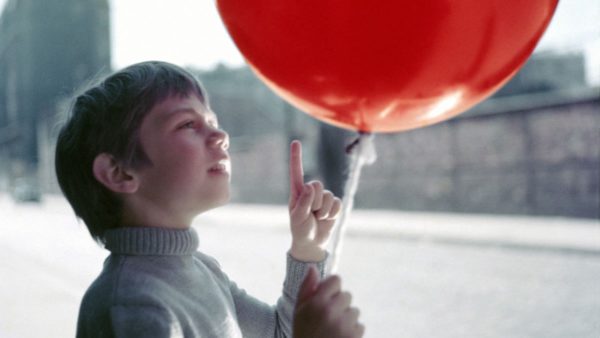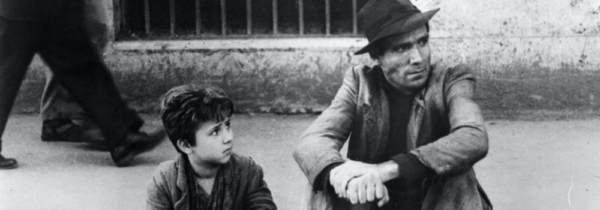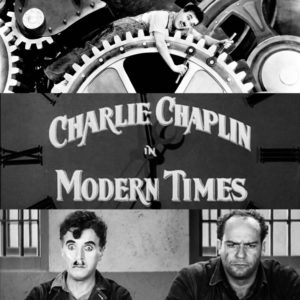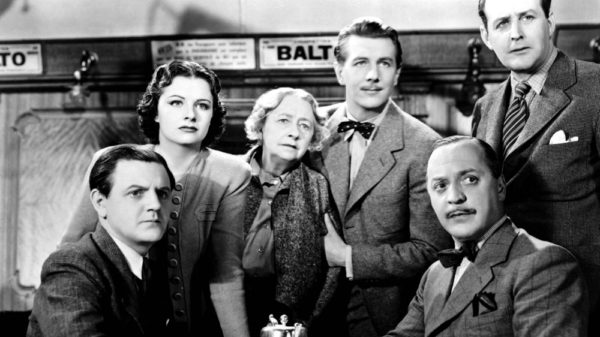
How to develop a family movie night and introduce your kids to classic films
Photo: A balloon befriends a young boy in Albert Lamorisse’s “The Red Balloon” (1957).
By Daniel Murray
If your family is like ours, there is a lot of screen time happening while we shelter in place. Almost every night is movie night. This is an excellent way for families to de-stress, especially parents, at the end of a long day juggling jobs and homeschooling. Mixing in some classic films can bring much-needed joy while helping kids to learn, create, and grow. It can also foster a lifelong love of cinema for the whole family.

I majored in film at UCLA and spent countless hours watching hundreds of films. Now I’m the dad of a 3- and 7-year-old, and I want to share my love of cinema with my kids. When my oldest was 2, I started to experiment with showing her classic films. My kids love it, and I think all kids can enjoy and benefit from a love of great movies.
I think we do our kids a disservice by only exposing them to the kind of content typically on offer in the “kids” section of streaming services — shortening their attention spans, training them to expect hyper-stimulation, and limiting their appetite for more interesting, imaginative, and complex stories. Certainly, there are plenty of good reasons to let kids watch some short cartoons — sometimes we need to cook dinner, or it’s raining or we need to sleep in.
But in general, I think we would be better off concentrating our kids’ screen time to watching feature-length films with them. There is a world of classics, cult favorites and art house films that can develop kids’ creativity, concentration, narrative comprehension, empathy and aesthetic appreciation.

Art house and cult films are a great way to develop kids’ creativity. The stop-motion special effects of Ray Harryhausen in “Jason and the Argonauts” and “The Seventh Voyage of Sinbad,” for instance, are more tangible and tactile than the slick special effects in newer movies. Get out that play dough and see what your kids can do.
Errol Flynn’s classics “The Adventures of Robin Hood” and “The Sea Hawk” are fodder for countless backyard adventures. Baz Luhrmann’s stunning cult classic “Strictly Ballroom” will have them dancing circles through your house. And when they are ready for it, the 1930s Universal masterpieces “Dracula,” “Frankenstein” and “The Invisible Man” will have them digging through costumes to create their own spooky stories.
Classic films can also help to develop kids’ concentration and narrative comprehension. Most kids’ shows and movies today are hyper-stimulating. They grab kids’ attention and don’t let go. Classic films often move at a more measured pace, but that doesn’t mean they’re boring. Great films draw kids into a story. More complex narratives encourage kids to put together the pieces of a puzzle or notice how a character transforms.

Many classic films can also teach kids about empathy, good judgment, and social issues. Some feature complex characters who have to make tough choices or confront injustice. In “Bicycle Thieves,” a poor father struggles to find work to support his family and is forced into making some bad decisions. The film provides a child character with whom kids can identify. It creates the opportunity for conversations about choices and inequality, but it doesn’t provide easy answers. Others, like “The African Queen” and “High Noon,” offer role models of courage in the face of adversity.
Finally, great films are often beautiful films, filled with images that will help your child see the beauty in the world. Art house films, in particular, often utilize poetic images to tell a story or help us to learn about a character. They can turn the mundane into a breathtaking canvas through the use of color, composition, or camera movement.
I sometimes point out what I think are beautiful shots, and now I find my 7-year-old even says, “Look at that shot!” She connects images from films to things she sees in the world around her. The impact of exposing kids to this aesthetic is not always evident. Still, I hope it’s cultivating their visual sensibility, teaching them to examine images and appreciate beauty, as well as helping them understand film as a mode of creative expression.

How to get started planning a family movie night:
If you love film and want to foster that kind of love in your kids, it can also be a lot of fun. Here are five recommendations to guide you in the process.
1. Start early.
Whether we mean to or not, we already set your kids’ expectations for the kinds of movies and shows out there. With our kids, my wife and I pretty strictly followed the guidelines for no screen time before age 2 (well, at least with our first daughter). Our daughter only had screen time to talk to relatives and grandparents on video chat. We didn’t use our phones in front of her. We never had the TV on while she was around or awake. She never watched a cartoon.

On her second birthday though, we watched her first film — Charlie Chaplin’s “Modern Times.” The film is silent and black & white. But it is also hilarious, endearing and visually arresting. Having never seen a screen or a movie, she was enthralled. She had no idea that there were kid raves like “Trolls” out there (btw: I love “Trolls” and so do my kids). To her, Chaplin’s 80-year-old film was the hot new thing.
Rather than gradually building up from short cartoons that are hyper-stimulating, we built up from films that were silent and black & white. There is plenty of stimulation in these films to keep kids engaged. Exposing them early creates both an attachment to this kind of film, and a willingness to explore a broader range of media.
2. Allow for choice and variety.
This might be the most critical recommendation: At our house, we rotate who gets to pick the movie. This is a strict rule. There is no arguing and everyone is free to choose when it is their pick — even our 3-year-old. Of course, my kids are limited by the movies available to them, but they use their power.

We watched “Return of the Jedi” pretty much every time it was my daughter’s pick, every week for three months — that’s 12 times. This gives kids some control, so they can pick “Frozen II” and there is no fuss, but they also accept when I show them “The African Queen.” That way we also get a lot of variety. Sometimes they surprise me and request one of the classics for their own pick.
3. Create the right energy and environment.
At our house, we make movie time a family activity. We all sit together and get cozy. I often make popcorn. While this is partly because I love popcorn, I also make it strategically. When I know the movie might require a little more focus, I put in a little extra effort to make it an event. I dim the lights to create a movie theater atmosphere. I build up their excitement for the film over dinner.
This strategy usually works, but sometimes the energy isn’t right. Sometimes my kids would rather run around, giggle or be tickled. You’ve got to read the room and know whether it’s the right time, which brings us to the next recommendation.

4. Accept failure.
Sometimes the film won’t work. On quite a few occasions, I’ve had to cut off a film early because I realized it was over their heads, too scary, inappropriate in some other way, or the energy just wasn’t right that night. We switch to a trusty favorite and they are no worse for the wear.
5. Know your kids.
Every kid is different. Some scare easily, and some can follow a more complex narrative. And kids are ready for different films at different times. However, I do what I can to push the boundaries, rather than pander to them. I don’t believe there are kids that just can’t watch a black & white film or even a silent movie. It might take a bit more work and some strategy, but it is worth it.
Daniel Murray studied film and theater at UCLA and now works in higher education. He lives in the San Francisco Bay Area with his wife and daughters and enjoys making short films with his family and friends, like the epic “Pasta from Planet X!!!” You can follow his family film recommendations in Instagram @kid_cinematheque